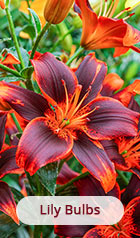Thank You!
We have received your request. You will be notified when this product is in stock.
X
Lily bulbs also come in a variety of colors and patterns, some with dark or light dots speckled across the flower. This distinct shape makes this flower a gardening staple. Not only do lilies add pops of color and cheer to the summer garden, but they also look outstanding in fresh floral arrangements and bouquets. For a spectacular display, choose a variety of lily bulbs, including ones with single and double blooms, as well as lily trees and shorter border lilies. While these beautiful flowers aren't super fussy about soil, they prefer sunny locations and will grow in full sun or partially shaded areas that receive several hours of direct sunlight.
What are the different types of lilies?
Just as each individual flower is bright and full of life, lilies are an amazingly vibrant and full family! Tons of diversity exists in lilies, but many lilies grown in the U.S. fall into two major groups: Asiatic and Oriental lilies. Those two varieties are well-loved for their big, bold flowers and their easy growing style. Although they have similarities, Asiatic and Oriental lilies are separate classifications. Let's look at those groupings, as well as other lilies to know!
Asiatic lilies
Asiatics are native to Asia, and bloom early in spring. Asiatic lilies grow in a rainbow of bright, variegated, or striped colors, ranging from pastels to deep jewel tones. Trogon lily, a variety with unique coloring and vigorous blooming, belongs to the Asiatic group. Asiatic lilies have long, glossy leaves with bright green coloring, and grow mostly on tall stalks, although there are also dwarf Asiatic lily varieties. Asiatics' blooms tend to be smaller than those of oriental lilies, and their petals have smooth edges.
Oriental lilies
Oriental lilies are known for their huge blooms and fragrant perfume: the sweet and spicy aroma of Oriental lilies is a sure sign of summer! Oriental lilies include many of our beloved "big flower" varieties, like Stargazer and Casa Blanca, and often grow in hues of pink, purple, white and red. The petals have ruffled edges, and sometimes feature gorgeous freckling. Oriental lilies grow a bit taller than Asiatic lilies, with blooms up to nine inches in diameter. They bloom in summer, with some varieties extending into fall.
Turk's Cap Lilies
Turk's Cap lilies feature distinctive petals, pointing backward from the stamen of the bloom. These precious blooms tend to dangle from the end of their stalks, and flower in shades of orange, pink, yellow and red.
Trumpet Lilies
Trumpets are hardy lilies with unmistakable trumpet-shaped flowers. The long bells of these blooms are easy to spot, and you won't miss their perfume, either! Trumpet lilies can grow to taller heights than most other lilies, and are extremely fragrant.
Tree Lilies and Other Hybrids
Because lilies are cold-hardy, beautiful, and easy to grow, gardeners have cultivated thousands of varieties of their beautiful flowers. For example, our Tree Lilies are a cross between Asiatic and Oriental lilies, combining the best traits of both species into one tall plant with big color and sweet fragrance. Tiger lilies, Easter lilies, and other classics are hybridized for their specific color and shape. And, Orienpet species occur through hybridization of trumpet lilies and other lilies with brighter flowers. Whatever you're looking for in a spring or summer bloom, a lily exists to fill that need.
What do lily bulbs look like?
Lily bulbs look somewhat like other flowering bulbs--they have roots on one end and a point at the other--but are actually grown through a different mechanism than daffodils or tulip bulbs. Lily bulbs are actually non-tunicate tubers, meaning they don't have a protective papery cover. Lilies form bulbils at the base of the leaf axils on the plant and these can be propagated to grow new plants.
When to plant lily bulbs:
Lily bulbs can be planted in the fall or early spring, after the threat of frost is past. If planting in fall be sure to get your lilies in the ground 3-4 weeks before freezing temperatures to allow good root production. Lilies do not go completely dormant in the cold months so they don't require a specific number of cold hours to bloom, this is what allows them to be planted in early spring as well as fall. Planting lily bulbs too late in the summer may, however, may prevent them from blooming and collecting energy for the cold season ahead.
How to store lily bulbs:
Lily bulbs should be planted in the spring, as soon as you receive the bulbs. Don't store your lilies unless you absolutely have to! However, some gardeners in very cold climates choose to lift their lily bulbs overwinter to protect them from the freeze. If you find that you need to lift and store lilies, make sure that the foliage has died back, and lift the bulbs very carefully.
Let your lily bulbs cure, or dry, for a few days in a cool and dark location. Then, store them in a breathable container to avoid mold or mildew setting in. Try using a cardboard box, paper bag, or mesh container with peat moss inside. Wait until mid or late spring to replant your bulbs.
How to grow lily bulbs:
Not only are lilies beautiful, they're very easy to grow. You need only choose a good location and provide them with a little attention, and you'll have eye-popping big and bright blooms!
Choose a location with full sun and good drainage for your lily bulbs. Make sure to give them room to grow, considering both height and width, as these plants prefer not to be crowded. Since lilies naturally grow in clumps, consider planting a grouping together for a naturalized look. Check the planting instructions to determine how deep to plant your lily plants, then break up the ground and dig holes of the appropriate depth. You may wish to add a little flower fertilizer in the bottom of each hole. Be sure to mix the fertilizer with soil, to keep the harsh fertilizer from burning the bulbs.
Plant your lilies with care and with their point facing upward, then backfill the soil and water your lilies in well. After planting, your lilies will only require watering throughout the growing season! A light, balanced fertilizer may encourage blooming, and deadheading your lilies after they bloom will keep the plants looking clean. After the flowers have faded, don't cut back your lilies stems--allow them to stay upright until their leaves fade, to allow the plant to collect energy for the winter.
Every few years, you may find that your lilies look crowded--that means it's time to divide. Dig up your lily bulb, and look for new clumps forming along the main bulb. Carefully pull those off, and replant them for even more beautiful blooms.






















